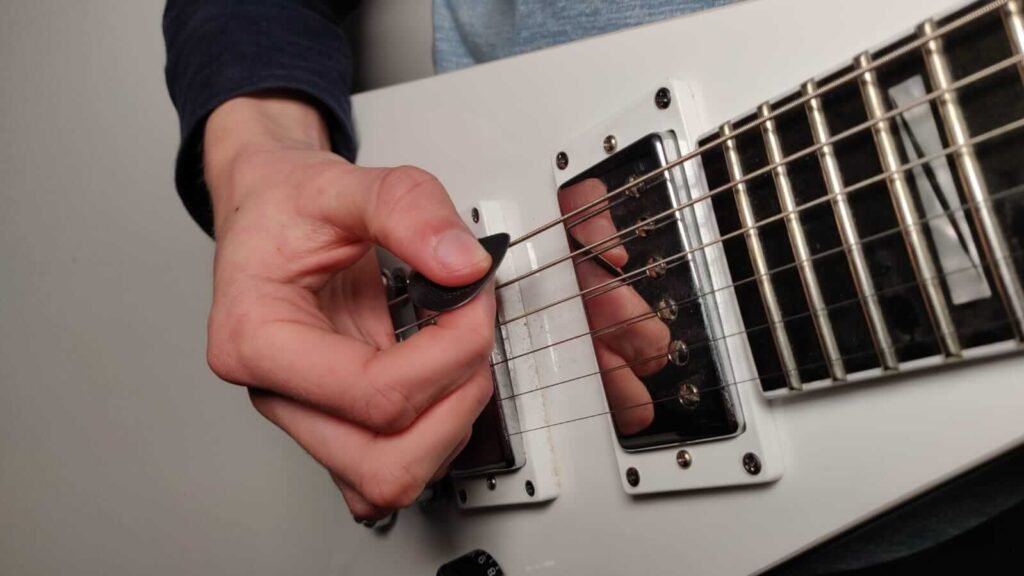From the bone-shaking riffs of thrash metal to the atmospheric soundscapes of post-rock, the “chug” has become a cornerstone of guitar expression. This potent technique, characterized by rhythmic downstrokes on distorted electric guitars, pulsates with raw energy and undeniable sonic appeal. Within its seemingly simple mechanics lies a universe of sonic possibilities, shaping a diverse range of musical genres and igniting countless headbanging moments.

What exactly is Guitar Chugging?
Let’s delve into the heart of the chug, exploring its technical foundations, diverse applications, and cultural impact across the fretboard landscape.
Anatomy of a Chug:
- The Tool: An electric guitar equipped with high-gain distortion is the foundation. Distortion amplifies the signal, adding grit and saturation, crucial for shaping the chug’s distinctive rawness.
- The Power Stroke: The chug hinges on repetitive downstrokes with the picking hand. Varying picking speed and palm muting techniques create nuanced dynamics and rhythmic textures.
- String Selection: Lower gauge strings (9s or 10s) are often preferred for chugging, emphasizing the low-end power. Tuning variations, like drop D or baritone tunings, further deepen the sonic impact.
Beyond the Basics:
While the core technique appears straightforward, mastering the chug demands exploration and refinement:
- Palm Muting: This essential technique involves muting unwanted string noise with the picking hand palm, sculpting tight, percussive chugs. Experimenting with varying muting pressure and timing creates rhythmic nuances.
- Picking Variations: Alternate picking (down-up-down-up) adds fluidity and speed, while triplets or down-down-down-down patterns generate aggressive intensity.
- Rhythmic Playgrounds: Beyond simple downstrokes, explore syncopations, ghost notes, and double strokes for intricate rhythmic textures.
Genres Fueled by Chugging:
The chug’s versatility shines across various musical landscapes:
- Heavy Metal: From the proto-chugging of Black Sabbath to the modern shred of bands like Metallica and Slipknot, the chug forms the backbone of heavy metal’s sonic assault.
- Thrash Metal: The genre takes the chug to hyper-speed, characterized by fast tempos and aggressive palm muting techniques, exemplified by bands like Slayer and Megadeth.
- Stoner Rock/Doom Metal: Slow, down-tuned chugs create heavy, atmospheric soundscapes in bands like Kyuss and Sleep, evoking a sense of brooding intensity.
- Post-Rock/Shoegaze: Chugs can be employed for more atmospheric textures, layering sonic textures and building sonic crescendos in bands like Explosions in the Sky and My Bloody Valentine.
The Cultural Impact of the Chug:
- Headbanging Heroics: The chug’s primal energy fuels the iconic act of headbanging, a ubiquitous expression of musical enjoyment and shared experience within heavy music communities.
- Sonic Rebellion: The chug became a sonic symbol of rebellion and counterculture in the 80s and 90s, associated with the rise of heavy metal and its anti-establishment values.
- Evolution and Innovation: From the classic metal chug to the experimental soundscapes of post-rock, the technique has continually evolved, reflecting diverse artistic expressions and influencing new generations of guitarists.
Learning the Chug:
If you’re eager to unleash the chug yourself, here are some starting points:
- Master the Downstroke: Start with slow, clean downstrokes on a single string, focusing on accuracy and picking consistency.
- Introduce Distortion: Gradually add distortion, experimenting with different levels to find your desired sonic character.
- Explore Palm Muting: Begin with basic muting exercises to control string noise and refine your chugging sound.
- Learn Classic Riffs: Analyze and practice iconic chugging riffs from bands like Metallica, Slayer, or Black Sabbath to develop your technique and vocabulary.
- Find Your Voice: Don’t be afraid to experiment, explore different rhythms, and infuse your own musical personality into your chugging.
Conclusion:
The humble chug, beyond its seemingly simple form, offers a world of sonic possibilities. It’s a powerful tool for guitarists of all levels, adding rhythmic punch, raw energy, and emotional depth to music across diverse genres. So, grab your guitar, crank up the distortion, and unleash the power of the chug in your own musical journey!
How do you Chug an Acoustic Guitar?
While “chugging” in guitar playing typically refers to a technique used on an electric guitar with distortion, you can achieve a similar rhythmic effect on an acoustic guitar, though it won’t sound exactly the same. Here are a few approaches:
1. Palm Muting and Strumming:
- Use a pick and mute unwanted string noise with the fleshy part of your palm near the bridge.
- Experiment with different strumming patterns, focusing on downstrokes for a more percussive sound.
- You can create rhythmic variations by incorporating muted upstrokes or partial mutes.
2. Body Percussion:
- Use your hand to tap rhythmically on the body of the guitar while strumming, creating a percussive chugging effect.
- Explore tapping different areas like the soundboard or sides for subtle tonal variations.
- This technique adds a unique element but requires coordination and practice.
3. Fingerstyle Techniques:
- Use percussive fingerpicking techniques like slapping or tapping the strings with your nails or fingers.
- Experiment with rhythmic patterns using these techniques and combine them with regular fingerpicking.
- This approach offers more control and articulation compared to strumming but requires precise finger control.
Things to Remember:
- Acoustic guitars lack the distortion that gives the electric chug its signature growl. Focus on creating a percussive, rhythmic feel instead.
- Experiment with different picking and muting techniques to find what works best for you.
- Practice regularly to develop your timing and rhythmic accuracy.
- Remember, while you can achieve a chug-like effect on an acoustic, it won’t sound identical to an electric chug due to the absence of distortion.
Additionally, be mindful of the impact these techniques might have on your acoustic guitar’s body and strings. Consider practicing on a less valuable instrument if you’re unsure about the potential wear and tear.
Ultimately, the key is to be creative, explore different approaches, and find what sounds good to you!
How Do You Make Guitar Tabs?
150 Guitar Tabs
Why does my Guitar Amp sound Muddy?